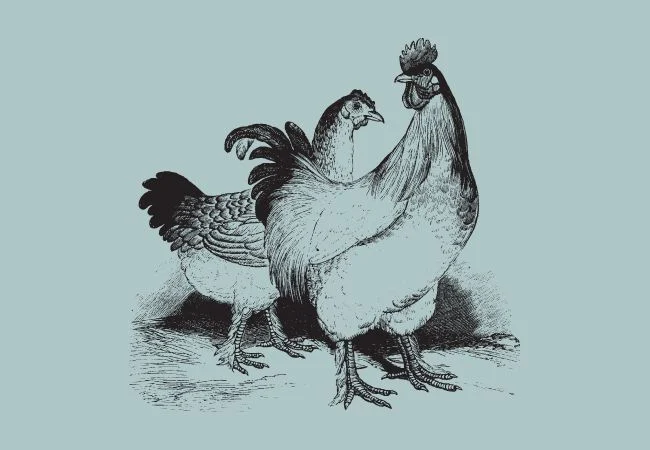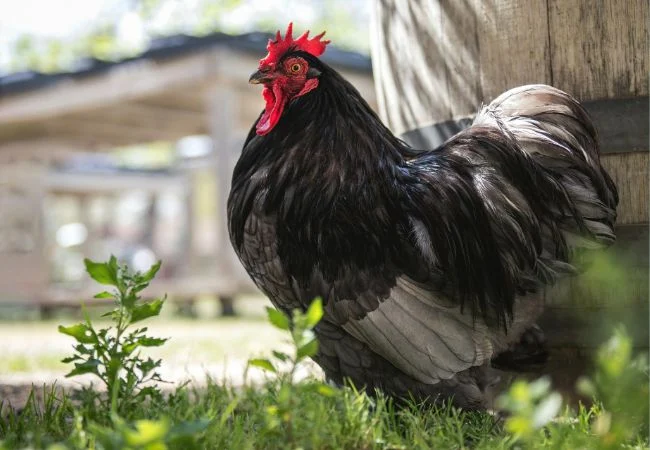I. Introduction
If you’ve never raised a pet chicken before, you might think chickens are just plain farm animals—not exactly the cuddly or captivating type. But the reality might surprise you.
More and more people are falling in love with ornamental chickens—not just as backyard companions, but as a source of daily joy, a way to relieve stress, and even a delightful “living toy” that helps kids learn about animals and responsibility.
Among the most popular ornamental chicken breeds, Bantam Chickens Cochin stand out for their adorably fluffy appearance and calm, friendly nature. They’re a top choice for anyone looking to start raising chickens at home, especially in smaller yards or suburban settings.
Let’s dive into what makes this tiny, feather-covered breed such a crowd favorite.

II. What Are Cochin Bantam Chickens?
Origins and Breed History
The Cochin chicken originally comes from China and was introduced to the Western world in the early 19th century. The first Cochins were large birds, known for their heavy feathering and regal appearance. Over time, chicken enthusiasts and breeders developed a smaller version called the Cochin Bantam.
These miniature birds retain all the signature fluff and charm of the full-size Cochin but are far more compact, making them perfect for backyard coops, decorative flocks, or even as pet chickens.
Though Cochins weren’t originally bred as ornamental chickens, their striking features and gentle personalities quickly made them a favorite for display and companionship. Over the last 200+ years, Bantam Chickens Cochin have earned a loyal following among backyard poultry keepers and show bird enthusiasts alike.
Key Traits of the Cochin Bantam
1. Appearance and Personality
When it comes to pets or ornamental animals, the first thing most people look for is an eye-catching appearance—and personality is just as important. So how does the Cochin Bantam stack up?
Physically, Cochin Bantams are covered in thick, soft, fluffy feathers that extend all the way down their legs and feet, giving them a round, puffball look that’s irresistibly cute.
In terms of temperament, this breed is famously docile, gentle, and affectionate. They tend to get along well with both adults and children, making them an ideal choice for families.
Now, full-sized Cochins can weigh 6–9 lbs (3–4 kg or more), which isn’t always practical for small backyard spaces or decorative flocks. That’s where Cochin Bantams come in. These miniatures weigh just 1.3–2 lbs (600–900 grams)—about one-third or even one-fourth the size of their full-sized counterparts.
With their compact size and easygoing personalities, Bantam Chickens Cochin have become one of the top ornamental breeds for homes and hobby farms.
Another major plus? Their color variety. Cochin Bantams come in a rainbow of feather colors—white, black, buff, blue, partridge, red, and even rare color mixes. This means you can personalize your flock to match your aesthetic or gardening vibe.
These color options also make them highly desirable for poultry shows and chicken exhibitions. Who knows—you might end up owning a Cochin Bantam with ultra-rare plumage that wins a ribbon or two!

2. Easy to Raise and Weather-Resistant
Cochin Bantams are widely known as beginner-friendly chickens. Their thick feather coats make them especially tolerant of cold weather, so they do well in mild to moderately cold climates.
However, because of their dense leg and body feathers, their coops need to stay clean and dry. Damp or dirty environments can lead to skin problems or infections.
In hot weather, just make sure they have plenty of shade and fresh water to avoid overheating. With a little care, these birds thrive year-round.
3. Peaceful Flockmates & Low Flyers
Thanks to their calm demeanor, Cochin Bantams are easy to integrate with other chickens—whether it’s other bantams or standard-sized breeds.
They’re not great fliers due to their heavy feathering and shorter legs, so they tend to stay grounded and won’t escape the coop easily. This makes them easy to manage, especially if you have limited space or don’t want chickens hopping over fences.
4. Egg Laying & Broodiness
Although they’re not high-production layers, Cochin Bantams lay a respectable 80–120 eggs per year. The eggs are small but typically uniform and attractive, making them a nice bonus for families who keep chickens primarily as pets or yard companions.
One standout trait of this breed is its strong maternal instinct. Hens are known for their excellent brooding behavior and parenting skills. If you plan to hatch chicks, Cochin Bantam hens are some of the best mothers out there—loyal to the nest and gentle with their young, resulting in high hatch and survival rates.
5. Breed Consistency & Market Value
Because of selective breeding, Cochin Bantams reliably pass down their signature looks and mellow temperaments to the next generation. That consistency makes them a popular choice in the ornamental poultry market.
Whether you’re raising them for fun, showing them at local fairs, or selling a few chicks to other chicken lovers, Bantam Chickens Cochin are always in demand.
They’re especially suited to small farms, backyard flocks, or homesteaders looking to add something beautiful, friendly, and low-maintenance to their setup.
6. Social Behavior and Awareness
While they’re not as “trainable” as dogs or cats, Cochin Bantams are surprisingly aware of their surroundings. They recognize their caretakers, adapt to routines, and show affection in subtle ways.
Their gentle, sociable personalities make them even more charming, especially if you’re looking for chickens that feel more like pets than livestock.

III. Cochin Bantam Chicken Care Guide for Beginners
Thanks to their gentle temperament, thick plumage, and compact size, Cochin Bantams are an ideal breed for keeping in small backyards or home gardens. However, to keep them healthy and bring out the best of their traits, there are a few important things to keep in mind:
• Provide a Suitable Living Environment: Cochin Bantams don’t tolerate high temperatures well due to their dense feathers, which can make them overheat easily. Keep their living area cool and well-ventilated, with access to shade, and avoid direct cold drafts. In colder climates, make sure their coop is warm and windproof to protect them from the chill.
• Feeding: This breed is not picky eaters. You can feed them with commercial pellets or mix your own feed suitable for their small size. Adding fresh greens and small insects to their diet will boost their nutrition and help maintain glossy, healthy feathers.
• Clean Coop Regularly: Their thick feathers are prone to accumulating dirt and parasites, so regular coop cleaning is essential. Also, inspect your chickens frequently to spot any early signs of illness.
• Allow Space for Movement: Though Cochin Bantams have a round, stocky build, they still need space to roam and move around naturally. Providing access to a spacious backyard or an exercise area is important to keep them active and healthy.
• Separate Care for Hens and Roosters: Hens need a quiet, clean space to lay and brood eggs. Roosters can be more aggressive, so it’s best to either house them separately or limit the number of roosters in the same area to prevent conflicts.
• Monitor Health and Prevent Diseases: Due to their thick feathers, Cochin Bantams are susceptible to skin problems and parasites like mites and lice. Conduct regular health checks and use preventive treatments when necessary. Always keep their coop dry and well-ventilated.
• Lifespan: With proper care, Cochin Bantams can live between 6 to 8 years. This is relatively long for a chicken breed, allowing you to enjoy them as pets or ornamental birds for many years.
In summary, Cochin Bantams are friendly and easy to care for, making them perfect for beginners or anyone looking to raise ornamental or pet chickens. With the right care based on the tips above, you’ll have a healthy, attractive flock and a rewarding chicken-keeping experience.
You can learn more about how to care for and raise Cochin Bantams in detail from this comprehensive guide:
IV. Should You Keep Cochin Bantam Hens or Roosters? And How Many?
When raising Cochin Bantams, choosing between hens and roosters largely depends on your goals and living conditions.
• Keeping Hens:
If you’re raising chickens as pets or have young children at home, hens are the preferred choice. They tend to be gentle, friendly, and easy to bond with. Their strong maternal instincts make them excellent caregivers for chicks. Plus, their soft, fluffy feathers give them an adorable look, making them perfect for small gardens or family-friendly spaces.
• Keeping Roosters:
If your goal is to raise ornamental chickens for shows, collections, or to add a striking visual element to your garden, then a Cochin Bantam rooster is the top pick. Roosters stand out with their bright plumage, proud posture, and distinct crowing—traits that make them popular in poultry exhibitions. However, they tend to be more assertive and require more space and an experienced handler to manage their behavior and prevent conflicts within the flock.

• How Many Chickens Should You Keep?
For small backyard setups or home gardens, a flock of 3 to 5 chickens is ideal—typically with only one rooster to avoid territorial disputes and reduce stress on the hens. If you’re only keeping hens for companionship or egg-laying, you can increase the number depending on your available space and ability to care for them.
If you’re passionate about breeding and developing rare or unique chicks, you can start with three roosters and three hens. However, it’s important to keep the roosters separated until they’ve fully developed their plumage and signature colors. Once matured, select the most desirable rooster for breeding to help maintain and refine the traits you want in your flock.
Note:
Cochin Bantam chickens aren’t always readily available year-round from major hatcheries in the U.S. Be sure to check with trusted sources such as Meyer Hatchery, Cackle Hatchery, or contact local farm supply stores directly. Availability often varies by season and region, so staying proactive will help you find the right birds at the right time.
Accessories and Equipment:
Cochin Bantams require similar care equipment as other Bantam breeds. For detailed information on coops, feeders, waterers, nesting boxes, and other care tools, check out our overview post: Bantam Chicken Breeds. It includes everything you need to set up a well-equipped and comfortable space for your flock.

Conclusion
Bantam chickens Cochin are among the most popular and charming Bantam breeds, known for their fluffy appearance, calm temperament, and ability to thrive in a variety of backyard setups. Their care requirements and equipment needs are similar to those of other Bantams, making them a great choice for beginners and seasoned chicken keepers alike.
Whether you’re just starting out or hoping to add variety to your flock, raising Cochin Bantam chickens can be a fun and fulfilling experience.
Don’t forget to check out our full guide on Bantam chicken accessories to make sure your Cochin Bantams have everything they need to stay healthy and happy.

